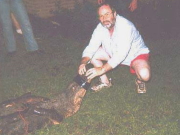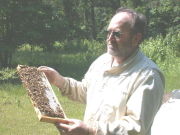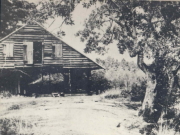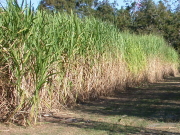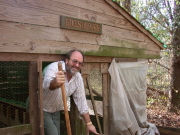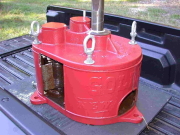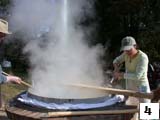Making Syrup (2004)
Aside from a few stalks that I grew by the edge of my garden, I did not have cane from 1960 until Fall, 2001. I harvested our first crop in 2002, and it was processed into syrup at the Griffin Syrup Mill. When I harvested our second crop, our mill had been restored and it was set up just inside one of the overhead doors of our workshop. Thus, I squeezed juice at home and took it for syrupmaking to the operation of Jerry and Anthony Brinson and family. Again, in 2004, we moved ahead incrementally. By this season, the furnace had been built; and, I had completed the layout, the plumbing rough-in, and subs had poured the foundation and run the gas lines through conduit I had put in.. (That is mostly the limit of the progress that can be made by an old working fellow on a pay-as-you-go plan, unfortunately.) Much to our pleasure, we were able to go from harvesting cane to bottled syrup on our homestead. Here, a few photos of that momentous (for us!) occasion are posted.
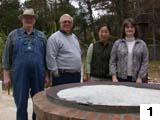 Much more when I was younger, I eagerly bounded from bed
early each morning and got to the task at hand. Thus, this fall morning, I had
squeezed the juice and filled the kettle by the time the work crew and technical
consultants arrived (Slide 1). Friends first, the late Zack Hicks is in overalls
and is standing by his and my friend, Leon Robinson. No two men ever enjoyed
making syrup more; among my most cherished memories are my time spent with Zack
and Leon. Both of them went far out of their way to help me. Although the
following has nothing to do with syrupmaking, it has everything to do with these
two syrupmakers. Following my mother's death in January, 2001, my sister "gave"
me two old clocks that had been stored on a shelf in the back of our farmhouse.
One clock had belonged to my father's mother, Della Sutton Outlaw. It had never
worked in my lifetime and a receipt inside indicated that Daddy had attempted to
have it repaired by either Albert Folsom or Hubert Warr in the 1960s. Not a
valuable clock, except sentimentally, it had lost the little luster it once had
(hands gone, bezel empty. . .). The other clock had belonged to my mother's
parents, Mark A. and Addie F. Watson. Sleeping during winter in my unheated
bedroom in their uninsulated home, I always had a sense of place when I heard
that clock strike on the mantle and the hogs lifting and dropping the metal lids
on the feeder outside my window. The Watson clock had stopped working long ago,
too. Without belaboring the point, Leon (an expert clock repairman) and Zack (a
mechanic) "borrowed" my clocks and returned them restored and working like new.
They even declined payment for the parts. Men like that don't come along
often.
Much more when I was younger, I eagerly bounded from bed
early each morning and got to the task at hand. Thus, this fall morning, I had
squeezed the juice and filled the kettle by the time the work crew and technical
consultants arrived (Slide 1). Friends first, the late Zack Hicks is in overalls
and is standing by his and my friend, Leon Robinson. No two men ever enjoyed
making syrup more; among my most cherished memories are my time spent with Zack
and Leon. Both of them went far out of their way to help me. Although the
following has nothing to do with syrupmaking, it has everything to do with these
two syrupmakers. Following my mother's death in January, 2001, my sister "gave"
me two old clocks that had been stored on a shelf in the back of our farmhouse.
One clock had belonged to my father's mother, Della Sutton Outlaw. It had never
worked in my lifetime and a receipt inside indicated that Daddy had attempted to
have it repaired by either Albert Folsom or Hubert Warr in the 1960s. Not a
valuable clock, except sentimentally, it had lost the little luster it once had
(hands gone, bezel empty. . .). The other clock had belonged to my mother's
parents, Mark A. and Addie F. Watson. Sleeping during winter in my unheated
bedroom in their uninsulated home, I always had a sense of place when I heard
that clock strike on the mantle and the hogs lifting and dropping the metal lids
on the feeder outside my window. The Watson clock had stopped working long ago,
too. Without belaboring the point, Leon (an expert clock repairman) and Zack (a
mechanic) "borrowed" my clocks and returned them restored and working like new.
They even declined payment for the parts. Men like that don't come along
often.
Next in the photo, Yun Kang was a Ph.D. student with me. She had completed her Masters at Beijing Agricultural University, which was the source of many who worked in my lab over the period roughly from 1986 til 2007 (Liming Shen firstly, Xue-Chen Wang, Xin Liu, Fanxia Meng, lastly, and Shuqiu Zhang, mostly; others, btw, such as Ping Lu, Tianran Jiang, and "Helen" He came from other universities in China). Anyhow, Yun was always eager to take on something new and different (even helping me at one point with building the furnace!). As I write this in 2010, Yun's obsession is fishing. Anyhow, I think she had a great day paling around with Zack and Leon.
Nedra's main role was to cook sausage and make biscuits. Nedra makes the best biscuits, and by all rights, she should cook well (she has a masters in Home Ec). But I will never compare her biscuits with anyone's. I learned my lesson about biscuits and you just can't take some things back. My mother was a traditional southern cook. Few things (cowpeas, biscuits, and cake, mainly) escaped the frying pan in her kitchen. Though she was modest to a fault, she was justifiably proud of the way she could and did set a table. I was more-or-less attached to her apron strings and we always made biscuits together. She did not roll them out, but pinched dough off and formed a ball of dough in her hand. Then, she placed the balls of dough on a pan and flattened them, forming three parallel bands with her middle phalanges. The last scrap of dough was always made into a "little boy" biscuit for me. (Never mind that this went on when she had to look up at me.) These biscuits were good for just about anything--plunge a thumb in the end and fill with syrup, and you've got a sweet snack; tear it open and stuff it with cured ham and you've got a salty snack; fill it with onion slices, mayonnaise, and pepper, and you have a savory snack; slice it, butter it, sprinkle with sugar and cinnamon, toast, and you have a fine follow-up to breakfast; &c. . . . those few biscuits that survived to old age positively delighted the chickens. Nedra, on the other hand, rolls her dough and cuts the biscuits. Mama used oil; Nedra uses saturated fat. Mama used any flour; Nedra is particular. Mama's dough was on the dry side, Nedra's is a little sticky. Anyhow, Mama always cooked what she thought I'd like every time I visited (and, later, when she couldn't, I always cooked what I thought she'd like and took it with me to her). I liked biscuits, so every time . . . . But, then, one day, about five years after Nedra and I married, Nedra made biscuits at Mama's house. Mama tasted Nedra's bisuits and the word "biscuit" never crossed our lips again and she never made another biscuit for me. I know it hurt her feelings terribly, and that is but one of a large list of things I contributed to or caused and wish had not happened.
I had, of course, boiled water in the kettle several times to
test it and make a rough 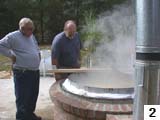 estimate of the efficiency of energy conversion of
propane combustion to reducing the water content of the nascent syrup. (If you
wish to calculate the latter for your furnace, I have done the legwork and laid
out the basic math in this link (pdf).) Regardless, water is not syrup, so I was
anxiously monitoring the progress while Leon babysat me (Slide 2).
estimate of the efficiency of energy conversion of
propane combustion to reducing the water content of the nascent syrup. (If you
wish to calculate the latter for your furnace, I have done the legwork and laid
out the basic math in this link (pdf).) Regardless, water is not syrup, so I was
anxiously monitoring the progress while Leon babysat me (Slide 2).
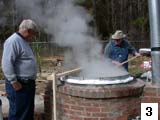 Neither before or since have I seen a person so obsessed with
skimmings as Zack was (Slide 3). No amount of discoloration should go untended to.
No hint of a skimming should slip by. Skimming was an artform for Zack..
Neither before or since have I seen a person so obsessed with
skimmings as Zack was (Slide 3). No amount of discoloration should go untended to.
No hint of a skimming should slip by. Skimming was an artform for Zack..
Yun (Slide 4) liked to be in the middle of the excitement. Here, she is shown using a skimmer that my daughter Elizabeth bought for me from a maple-syrup supply company.
Few sights exceed that of syrup cooking (Slide 5 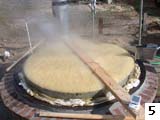 ), especially when it runs over the rim. Of course, that is a
personal judgement. Some syrupmakers use no rim and use the kettle as a large
vat. Their syrup is good. Other syrupmakers use two rims. Their syrup is good. I
use one removeable SS rim, because our family used one rim (which rests in my
backyard, not too distant from the cooking syrup). Naturally, I had some anxiety,
cooking in the open, but neither wind nor precipitation spoiled our time.
), especially when it runs over the rim. Of course, that is a
personal judgement. Some syrupmakers use no rim and use the kettle as a large
vat. Their syrup is good. Other syrupmakers use two rims. Their syrup is good. I
use one removeable SS rim, because our family used one rim (which rests in my
backyard, not too distant from the cooking syrup). Naturally, I had some anxiety,
cooking in the open, but neither wind nor precipitation spoiled our time.
As it should, the cooking liquid passed from a
lighter to a darker stage and the surface 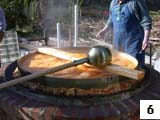 tension increased, resulting in larger bubbles. Not long
after Slide 6 was photographed, we bottled the syrup.
tension increased, resulting in larger bubbles. Not long
after Slide 6 was photographed, we bottled the syrup.
I learned a valuable (and unwelcome) lesson about syrupmaking that day. I purchased my flue from a local family-owned and old business that specializes in gas-burning appliances (commercial and home stoves, grills, fireplaces, and a little of everything). Lazy, I did not want to do my homework, so I had a consultation, described my set-up in detail, and they special ordered flue components for me. I examined the flue after we cooked this round. As the icon photograph (= the inside of the flue) unfortunately shows, pinholes were melted in the liner. Far better that I learn this fact before the shed was constructed! (I am aware of an instance in which the lesson was learned too late.) A personal tragedy befell the company principals and I was not of a heart to go back to them with this situation. I did, however, study carefully which flue would be needed and arranged for its installation in my shed before syrupping there.
